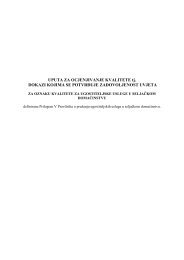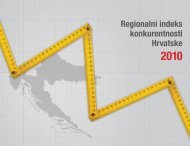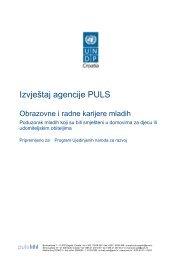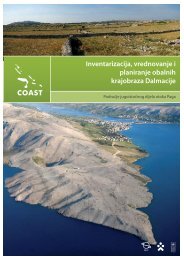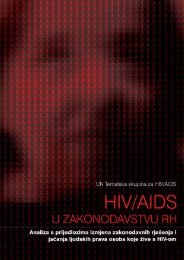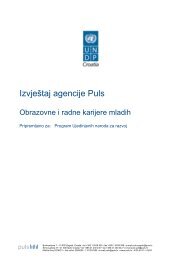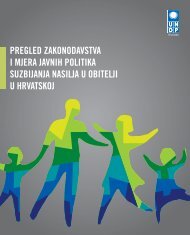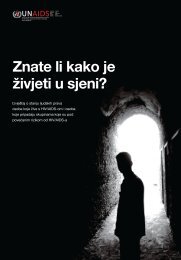THE SOCIALLY EXCLUDEDCHAPTER 3with the international community at the highest level,more than 40% of the 214 <strong>Croatia</strong>n Serb villages havebeen re-electrified and the overall process is scheduledto be finalized by the <strong>end</strong> of 2008.The OSCE has started similar advocacy actions infavour of the amelioration of infrastructure in returnareas in regard to water supplies and road maintenance.The OSCE has also produced analytical reportsencompassing all return villages/hamlets and ensuringthe adequate political and financial prioritisationfrom central authorities in the reconstruction of thenecessary infrastructure network.In 2006, the <strong>UNDP</strong> launched a local developmentprogramme in several counties in the Areas of SpecialState Concern which aims, amongst other things, toprovide limited infrastructure support to the mostneglected areas.3.3.9 Key ChallengesAlthough the economy is in transition and experiencingpositive growth, the improvement of social andeconomic life in areas of return is necessary for theintegration of returnees in <strong>Croatia</strong>. Counties whichsuffered the consequences of war and which havethe highest numbers of the returnees continue to lagbehind the rest of the country. If the present socio-economicsituation in return areas persists and if differentprogrammes for social and economic revitalisation donot begin to yield positive results, such conditions maycontinue to negatively affect the pace of return andfurther isolate returnees. This socio-economic situationmeans that once refugees have become returneesthey still rely on humanitarian assistance to facilitatetheir initial legal, social and economic reintegration intheir communities.3.3.10 Policy implications- All the obstacles impeding closure of the refugee filein the region should be removed, and all the politicalconditions, as well as legal and practical mechanismsenabling the sustainable return of refugees to <strong>Croatia</strong>should be created by the <strong>end</strong> of 2006 (as foreseen inthe Sarajevo Declaration).- The implementation of housing care programmesfor former Occupancy/Tenancy Rights holdersshould be accelerated. Property restitution andreconstruction assistance, in particular the resolutionof all p<strong>end</strong>ing appeals, should be accelerated andcompleted by the <strong>end</strong> of 2007.- Status problems of the displaced persons, whohave not yet acquired <strong>Croatia</strong>n citizenship, shouldbe resolved and working years in the former Serbcontrolled areas should be recognized for all thoseeligible under the Law on Co-validation.- Basic infrastructure in return areas should beimproved. The <strong>Croatia</strong>n Electric Company (HEP)should expedite the re-electrification of returnvillages, expected to be completed by 2008. Localand regional self-government bodies should workon improving and repairing water supply networksand road conditions.- Employment discrimination on minorityemployment in public institutions should beinvestigated and statistics collected. Strategiesto enforce and encourage minority employmentshould be developed and implemented.- Comprehensive development programmes thatfocus on all areas of return which reflect the specificneeds of returnees should be developed.- A long-term strategy should be adopted aiming tophase out the physical separation between childrenof Serb and Croat ethnicity in Eastern Slavonia.59
CHAPTER 3THE SOCIALLY EXCLUDED3.4 People with Intellectual DisabilitiesBox 4: A life storyMy name is Vladimira, but everybody calls meVlatka. I was born in Zagreb in 1960. After I wasborn, I couldn’t live at home, so they found mea new family. After some time, I returned to mymother. In 1969, my mother took me to the StančićRehabilitation Centre.It was not very nice in the institution, becausethere were a lot of us in the room and I didn’t getto have my things with me. I made handicrafts inthe workshop, but I didn’t get paid, so I couldn’tbuy myself stuff that I wanted. We could leave theinstitution on our own, but only in a group withchaperones. I felt imprisoned, as if I lived in a cage. Idreamed of living outside, just like everybody else.One day they asked me whether I would like toleave the institution and live in Zagreb with two ofmy fri<strong>end</strong>s from Stančić. I could hardly wait for thenew year of 2001 when I took my first free steps andmoved into my first apartment.I had to learn a lot of things: to take care of myself,my apartment, to use the telephone and to take thetram and bus. The counsellors and my coordinatorhelped me.I got my first job in the Association, where I usedto deliver mail. I was not happy with that, becauseI wanted a real job. My wish has come true. I nowwork in a warehouse and I glue labels, get a salary,and I can buy what I need and want.I live with my boyfri<strong>end</strong> now, and I’m thinking aboutgetting married. My mother and sister, whom I amnow seeing again after many years, will come to mywedding.3.4.1 Human RightsIn <strong>Croatia</strong>, there are no published statistics for thenumber of people with intellectual disabilities(defined as those with IQs under 70) in the generalpopulation. However, according to the theoreticaldistribution (the Gauss curve), they account for about2.14% of the overall population 71 . This would translateinto approximately 94,962 people with an intellectualdisability, the majority having mild disabilities.While “the Constitution of the Republic of <strong>Croatia</strong>guarantees equal rights and freedoms to all, regardlessof g<strong>end</strong>er, race, national or social origin, social positionor other characteristics...“ and “The Republic of <strong>Croatia</strong>[promises to] provide special care for the protectionof persons with disabilities and their inclusion in sociallife,“ 72 people with intellectual disabilities experiencethe greatest deprivation of rights within the population.They are regarded negatively as incapable,dep<strong>end</strong>ant, even dangerous to themselves and tothe community in which they live. These prejudicesare used to justify their social exclusion and isolationthrough a separate system of the “special schools“ andlifelong accommodation in residential institutions. 73According to statistics from the Ministry of Healthand Social Welfare 74 , there were 78,681 “persons withphysical or mental disabilities” in “treatment” in CSWon December 31, 2004, with 6,797 of those in socialwelfare homes; 3,052 living in the 25 state-run grouphomes for children and adults with “physical or mentaldisabilities”, 1,416 were housed in 15 private grouphomes, and 2,329 resided in other types of homes (forexample, homes for the elderly and infirm or personssuffering from mental illnesses). It is presumed thatthe remaining 20,000 individuals with intellectualdisabilities are provided for by other systems (healthcare, education, and pension) which have residentialaccommodation.71 Kirk S.A, Gallagher, J.J., Educating Exceptional Children, Boston, 1989.72 Article 57 of the Constitution of the Republic of <strong>Croatia</strong>73 The term residential institution means a special social welfare home for incapacitated residents.6074 Ministry of Health and Social Welfare, Annual statistical report on applied social welfare rights, legal protection of children, the youth,marriage, family and persons deprived of business capacity, and the protection of persons with physical or mental disabilities in theRepublic of <strong>Croatia</strong> in 2004, www.mzss.hr



